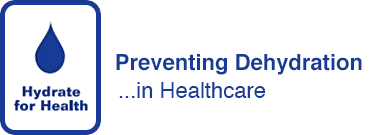Do care homes increase risk of dehydration?
A study compared dehydration levels of older hospital patients arriving from care homes with those living in their own homes and found care home residents at increased risk.
IN THIS ARTICLE
- How dehydration on admission to hospital differs between care home residents and those living independently
- Reasons why dehydration may be a problem in care homes
Older people and those who are infirm are at particular risk of dehydration (Campbell, 2011) – especially those in nursing homes or hospital, who may need help drinking to achieve adequate fluid intake. There are reports of NHS staff sometimes neglecting to give people this help (Francis, 2013).
Mild-to-moderate dehydration in older people is easily missed and often only detected on admission to hospital and when tests reveal hypernatraemia (high plasma sodium), a common sign of dehydration. Most research, however, looks at hypernatraemia occurring during hospital admission or fails to differentiate between hypernatraemia that was present on admission and cases in which it arose later.
New evidence
A recent study by Wolff et al (2015) linked hospital admissions with care home residency to see whether patients from care homes are at higher risk of hypernatraemia than those living in their own homes and, consequently, more likely to die in hospital.
All patients aged 65 years and over on first admission to Barnet and Chase Farm Hospitals Trust between January 2011 and December 2013 were reviewed as part of the study. Data recorded comprised:
- Age;
- Gender;
- Admission type: emergency or planned;
- Presence of dementia;
- Abode: care home or own home.
Laboratory data was used to assess whether patients were dehydrated on admission and whether they subsequently died in hospital. The presence of hypernatraemia in the first 24 hours of admission was used to measure dehydration.
The authors reviewed 21,610 admissions and 432 cases of hypernatraemia; 1,413 hospital deaths were recorded. Older people living in care homes were 10 times more likely to be admitted to hospital with dehydration than patients who lived in their own homes. Only 1.3% of patients from their own homes had high plasma sodium levels caused by dehydration, compared with 12% of patients from care homes. Compared with own-home residents, those from care homes were older and more likely to have dementia. However, after adjustment for age, gender, admission type and presence of dementia, the risk of high sodium levels was still more than five times higher in care home residents.
While admission from a care home was not inevitably associated with hypernatraemia, the probability was significantly increased in about a third of care homes. The lowest probability of hypernatraemia on admission was for own-home residents with no diagnosis of dementia, followed by own-home residents with dementia. Next were care home residents with no dementia followed by care home residents with dementia. Adjusted figures also showed care home residents were about twice as likely to die while in hospital. Hypernatraemia itself was associated with a five-fold greater risk of in-hospital mortality.
Discussion
The results confirmed the risk of hypernatraemia was higher in patients from care homes than those living independently, and that its presence on admission is an important predictor of in-hospital mortality. The authors note the reasons for this are not clear and beyond the scope of their study but suggest it could be that residents are choosing to drink less than they should, or staff are not offering them enough water to reduce incontinence and the assistance they require; however, there is relatively little research in this area.
Conclusion
The authors conclude that too many patients admitted to hospital from care homes are dehydrated on admission, leading to unnecessary loss of life. Further research is needed into the reasons for this. They suggest hospital staff should alert the care home GP if a resident is admitted with plasma sodium levels >145mmol/litre and, if it recurs within a set time period, consider reporting it to the Care Quality Commission as it may indicate a problem at that care home.
Ann Dix is a freelance journalist.
References:
Campbell N (2011) Dehydration: why is it still a problem?Nursing Times; 107: 22, 12-15.
Francis R (2013) Report of the Mid Staffordshire NHS Foundation Trust Public Inquiry.
Wolff A et al (2015) Are patients admitted to hospitals from care homes dehydrated? A retrospective analysis of hypernatraemia and in-hospital mortality. Journal of Royal Society of Medicine; 108: 7, 259-265.
Article taken from: Nursing Times 18.08.2015
